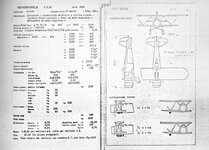Not sure if you're just trolling or just not understanding what I'm saying. Clearly in WW2 there were not such things as attack helicopters, even though there were experiments with them dropping bombs and mounting MGs on them. I said as attack helicopter equivalents in the post-Korea sense, though perhaps in the parlance of the time I should have said as 'ground attack aircraft' as CAS was known at the time, though this misses the sense that I mean it. I meant for it to be used in the way modern attack helicopters are, as integral to the divisions or corps they support rather than as separate air force air support.
Okay, here we go. Not trolling at all. I simply don't see the value in doing this. In hindsight it might seem like a good idea, simply because you are informed enough to know that attack helicopters were a thing after WW2, whereas the RLM was simply not. Nor were they informed enough to think that the aircraft was needed, otherwise it would not have been brought out of production. The memory telescoping comes because you know what happened subsequent to the decision not to build the aircraft anymore, whereas those who made the decision did not.
Not sure why you think the requirements for a cheap, affordable, low maintenance attack aircraft rendered the HS123 obsolete given that history showed the exact opposite.
The HS 123 was obsolete because it was too slow, couldn't carry a large or wide variety of weaponry, which, these things meant it was not a versatile adaptable airframe and was out of production, so its use later on was conditional on parts supply. Its use after it ended production does not change that it was obsolete. The use of obsolete weapons took place across the war, that did not change the fact those weapons were obsolete. You improvise with what you have, not necessarily what you want or would like to have. If all you have are obsolete aircraft, you use them because you need them. On the subject of usefulness beyond what was intended, d'you think that strapping Panzerfausts to the wings of Bucker Bestmann aircraft was intended? Do you think they should have all been manufactured that way because they were later used that way?
There were only about 300 available for the invasion of Barbarossa. Only about 360 had been built by September 1st 1939. Again it was designed to be a superior dive bomber, which is the opposite of a CAS aircraft and quite a bit more expensive than the Hs123.
The reason why there were so few LW aircraft available at Barbarossa was due to the losses suffered during the Battle of Britain. The Stuka was withdrawn because of high losses. German aircraft production could barely keep up with losses at that time. In this time the Hs 123 would have been a complete waste of resources as the LW needed more versatile aircraft at the time of Barbarossa. The Stuka was a dive bomber but it could be used in other roles, the D models were modified as tank destroyers and so forth, a more useful airframe than the Hs 123, so why would the LW have kept it in production again? Again to presume the Hs 123 could have been built in lieu of any other offensive aircraft was impracticable for the LW's needs as they were at the time.
So you're either trolling or just completely disengaged from this discussion.
Nope, I don't have to agree with you - fancy that, huh. Can you understand what that means? Just because someone doesn't agree with your premise does not necessarily mean you are being trolled, it means you are being disagreed with, not only that but I have presented my reasons for doing so, to which you have responded with disdain, indicating you don't like being disagreed with. You don't have to accept my disagreements, just like I don't have to agree with your premise. It doesn't mean I am wrong to do so nor does it mean I am trolling. Welcome to adult debate.

